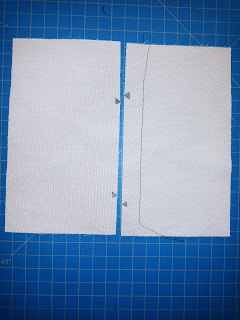Whenever I have a sewing class or private lessons, I
provide my students with a Treasured Guidelines folder. One of the most
important pieces of information included in that folder is, Sewing Terms and
Definitions.
Today we will be going over part II in this series, if
you missed part I, you can read about that here. Before, we dive in; I mentioned in the previous
post, that we were defining the following: clipping & notching, ease,
facing, finishing seams, and fraying. We will define those; however, I forgot
to include DARTS and FUSE/FUSIBLE…I don’t know what I was
thinking, but I will include them in the post today and put them in
alphabetical order! So, instead of 5 definitions in this post, we will cover 7
definitions. So please forgive me for that oversight, and let’s get started.
CLIPPING/NOTCHING:
seam
allowances are clipped and notched at the curved areas, so that when they are
turned through they will lay flat. Clip inner curves by snipping up to, not
through stitching, with diagonal snips. Notch outer curves by taking little
wedge shaped cuts form the seam allowances.
In the example photos, the outer curved seam is clipped
in wedge shaped cuts and when it’s turned right side out and pressed, that
curved seam is flat.
DARTS:
these
are used to shape garments to the contours of the body. Darts are usually at
the bust, hips, shoulder line or elbows to allow fabric to fit the contours of
the body. The point of the darts should always point to the fullest part of the
body. There are two types of darts, a single-point dart and a two-point dart.
The single-point dart is wide at one end and point at the other end. The two-point
dart has points at both ends and is wide in the center of the dart.
In the example photos, I show you the single-point dart
before it is sewn and after it is sewn. The next photo is the two-point dart
before and after it is sewn.
EASE/EASING:
is
to draw the fiber of fabric closer together than they were woven or originally
manufactured. This is usually achieved with machine basting. When easing in
fabric, no tuck or gathers are made in the fabric. Easing in the fabric allows
a curved capped sleeve to fit in to the straight line of a jacket armscye to
which the sleeve is sewn.
In the example photos, you’ll see the fabric with the
black notches need to fit between the notches of the fabric on the right. When a
machine basting line is stitched to ease to fit within those black notches,
then it can be sewn slowly and careful to prevent puckers. Once it’s ironed
properly, you can see there are no puckers.
FACING: a
facing is the area of a garment or sewn item that turns to the inside, giving
the finished appearance to what would otherwise just be a raw edge of fabric. The
facing is usually interfaced to add shape and structure to the inside of the
garment or sewn item.
In the example photos, you can see where the section of the half collar with the clothing label (shameless plug for my design business J) is a little more firm that the other layer of fabric that is because it was interfaced to add structure with in the collar.
FINISHING
SEAMS: used on most woven fabrics, finish seams by using pinking
shears, overlock/serge, overcast with a zig-zag stitch, turn fabric edges
under, straight stitch, or cover the edge with seam/bias binding.
FRAYING:
this
happens to most woven fabrics when fibers become unwoven or unravel typically
through handling while sewing or laundering. Woven fabrics will fray while
wearing or washing which can cause the garment to come apart if the seams are
not finished properly.
FUSE/FUSIBLE:
refers
to using the fusible material, which melts to “glue” two layers together. This
melting action is done with a hot iron (no steam). In order for the fusing to
work, the fabrics must be pre-washed or preshrunk to remove manufacturers’
finishes. These finishes will prevent a good fuse from occurring. Fusible web
is available in a variety of weights and sizes.
This concludes today’s post. Next time, we will define Grainline,
Ham (Tailor’s Ham), Hems, Interfacing, Interlining, Nap/without Nap, and
Notions. We will cover these seven definitions along with example photos.
I hope you found this helpful! If you have some
definitions you’d like me to review, feel free to leave a comment.
Until next time!





















No comments:
Post a Comment